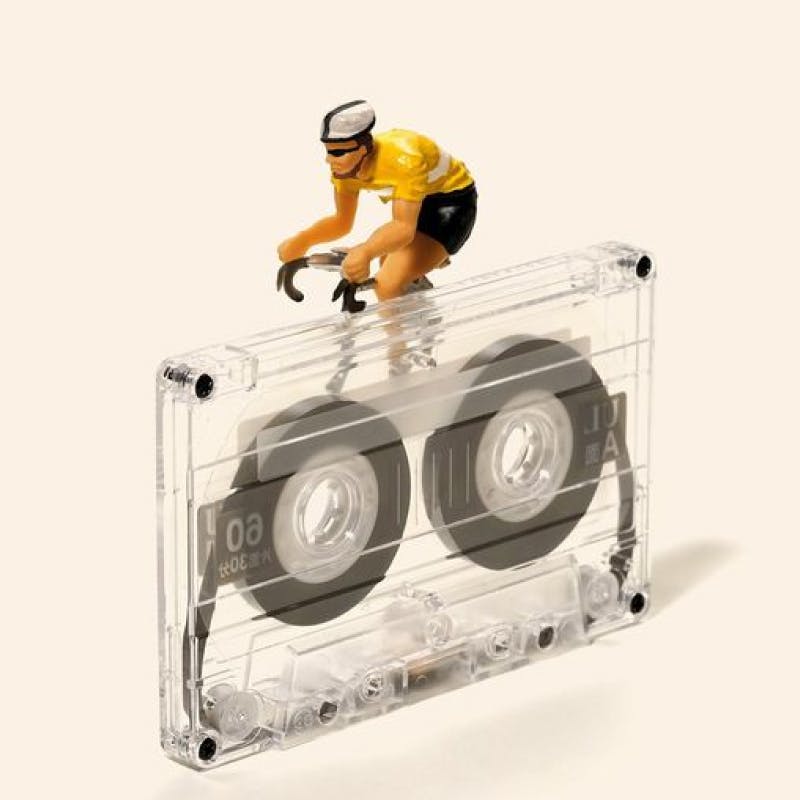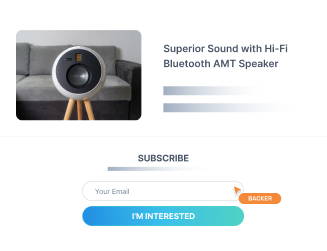If you’ve found this article, chances are you have an amazing product ready to launch and you’re already working on your product launch strategy.
There are many components to consider when launching new products, and setting up a campaign for pre-order products may be a strategy that fits your circumstance. If you’ve already done your homework by conducting market research, congratulations! You’re well on your way to launching.
In this article, we’re going to take a deeper look at the ins and outs of how to do pre-orders, the various pre-order methods, the benefits of pre-ordering, how to launch a pre-order campaign, and more.
What is a pre-order product?
Let’s start at the beginning. Before we get into all the nitty-gritty, you might be asking yourself, “What is a pre-order product?”
Pre-order products are items that haven’t been released into the market yet or are not currently in stock, but that customers can place an order for ahead of time. This means that a purchase can be made, and you can charge the customers for either a deposit or even a full payment before the product is ready to ship (and in some cases, even physically produced).
This process essentially reserves the pre-order products, with a guarantee to consumers that they will receive them the moment they’re released.
3 most effective pre-order strategies
Pre-order products are quite popular in eCommerce.
There are three main pre-order methods, which generally go in one of two directions. On the one hand, the retailer may choose to charge the customer immediately upon placing the pre-order. On the other hand, the retailer may choose to refrain from charging until the particular item has been shipped to the customer.
Let’s take a closer look at the most popular pre-order methods.
1. Pay-now
Pay-now pre-orders are among the most common types of pre-order products. The definition is in the name: the pre-order works like any standard online purchase, charging the customers instantly. The only difference between buying a pre-order product and a regular one is that the customer will have to wait longer for shipping.
This pre-order method eliminates the risk of the customer backing out of making the purchase later down the line.
2. Pay-later
Conversely, there is the pay-later pre-order method, which assumes an agreement between the customer and the retailer that the customer will pay for the product as soon as it is ready to be shipped.
There is an understanding through this pre-order method that either the seller or the buyer may back out of the deal in the future since there has been no exchange of money yet.
3. Crowdfunding
Finally, there’s crowdfunding. One of the many advantages of crowdfunding platforms is that it allows brands to list pre-production products as long as they offer a vague timeline of when they will be able to deliver.
Thus crowdfunding is considered to be another pre-order method, which is something more of an investment than an actual purchase. In the case of crowdfunding, the investment comes from regular people like you and me, and not from a bank, venture capitalist, or angel investor.
So how can you run a pre-order campaign on Kickstarter? Well, luckily, this pre-order method is practically ingrained in any crowdfunding platform.
Here, backers fund a crowdfunding product, understanding that they will only be charged if the goals of the crowdfunding campaign have been met.
4 Benefits of pre-ordering from a business point of view
Now comes the next question, “What are the benefits of pre-ordering? Well, the answer is not that simple. There are many benefits of pre-ordering and many reasons why eCommerce sellers decide to offer pre-orders for certain products.
We’re going to touch base on some of the most common benefits of pre-ordering.
1. Sales increase
Perhaps the most obvious and simple benefit of pre-ordering is the fact that you open yourself up to the opportunity for even more sales. By offering pre-order products, you are able to take orders and already start to receive money while still in the process of getting the product ready to ship.
What’s more, you’ll get the funding to actually move the manufacturing process along. There’s no need to let one operation bottleneck the other, as the two can take place simultaneously!
By offering pre-order products, you actually end up limiting your financial risk, since you’ll be able to collect payment when your customers submit their pre-orders.
2. Product demand prediction
Another fabulous benefit of pre-ordering is that gathering pre-orders will give you some pretty reliable metrics in terms of being able to accurately predict product demand! This is an often-overlooked benefit of pre-ordering.
When it comes to forecasting demands, pre-orders are an amazing tool.
By calculating the number of pre-orders a product gets, you’ll be able to accurately understand how much of that product you actually need to produce (depending on your pre-order business model).
This is valuable information to have for your future marketing strategy as well, as you can test the market interest in your product. Pre-orders are a great way to validate a product concept before actually committing to production.
This is a point that we will get into a little bit later, but essentially, by mocking up product images, you’ll be able to test the validity of varying features, designs, or even the product as a whole.
3. Increase brand awareness
Of course, anything can be used as an opportunity to create a buzz, and pre-order products are no different! If you’re looking to create hype around your brand or product, then consider limiting the number of pre-orders available or offering it for a limited amount of time (or both).
People love the special feeling that comes with exclusivity, and many are happy to consider themselves trendsetters. This mentality will also help bolster talk about you and your product thanks to social media and word-of-mouth marketing.
While you’re at it, once you send out your pre-order products to your first customers, you can use the opportunity to collect testimonials and user-generated content, and even conduct some customer research!
4. SEO component
It goes without saying that the more content there is out there about your pre-order products, the more chances there are to optimize the SEO of your pre-order landing page.
You can also choose to ride those PR waves by supporting them with your own form of content marketing, email marketing, or influencer marketing, helping to amplify the effect!
By already having all sorts of content on your website well before the release date, you’ll be able to work on your ranking in the meantime. This way you’ll be expanding awareness around your brand and your product and opening the doors to even more leads, all before your pre-order products ever get released!
When to offer a pre-order product and why
Producing and selling physical goods can take a lot of time, resources, and capital. Imagine investing thousands of dollars in developing a product and building up an inventory of something that might actually flop in the market.
Implementing a pre-order campaign is actually a great way of understanding your product-market fit.
As mentioned above, some of the key benefits of pre-ordering include product validation, demand estimation, and guaranteed financing. All this translates to much lower risks in the process of running an eCommerce business that deals with selling physical goods.
As for when to offer a pre-order product, it’s important to remember one of the main goals of a good pre-order marketing campaign is to make some noise and cause people to get excited.
Something else to keep in mind: A good pre-order campaign takes time to build.
That being said, it’s not necessarily wise to organize a pre-ordering campaign for every single item that you plan to sell. Save your pre-orders for your top offerings.
As a rule of thumb, it is more effective to use pre-order marketing when:
- launching large flagship products
- launching an entirely new brand or business
- offering limited-edition versions of a given product (activating that ever-present FOMO factor)
- offering a discount or promotion on an existing product in your line
- etc.
You want to avoid creating a pre-order product that is already in the market, doesn’t offer anything new, is simply one more product in your ever-growing catalog, or just doesn’t resonate with your target audience.
5 tips to find pre-orderers for your product
You need to start your pre-order campaign before the pre-order launch, and that takes some extra planning. Studies have shown that up to 28% of all pre-orders are placed on the very first day of pre-order availability. This isn’t magic, it’s the result of some amazing marketing.
A pre-order marketing strategy needs to be put in place, to make sure that your pre-order launch doesn’t flop. Your pre-order advertising has the goal of building an audience and helping you to gain momentum before your launch!
There are many amazing resources out there explaining how to structure a marketing pre-order program, but we’ve gathered some of the most important points here.
1. Make sure you have a social media presence
Do you have social media accounts for your brand? If not, now’s the time to create them. If yes, start utilizing them.
You need to set a marketing plan to help build customer awareness about what it is that you are planning to offer them.
Put a spotlight on your pre-order product well ahead of time by promoting your pre-order product on all your social media platforms.
Don’t forget that there is an opportunity to advertise on social media platforms. You can set up targeted digital advertisements to increase the amount of awareness of your product before launch.
2. Work with influencers
As part of the social media grain, it would be foolish to overlook the power of social media influencers. By now it’s no secret that consumers are at least 70% more likely to make a purchase based on social media referrals.
If, before the age of the internet, word of mouth was a valid means of gaining customers, then if anything, now we can say that the concept has simply been amplified.
Try sending your product to key different types of influencers whose audience fits in with your target customer. Give these influencers the opportunity to test and promote your product on their own social media platforms.
You may also offer these influencers a unique discount code to share with their audience (which is also a great way to track the level of success of the overall partnership).
You can offer special deals, or even set up a campaign that gives the audience a chance to win a prize (if they tag 3 friends for example, in the comments section, thereby causing a wave).
Use the materials (videos, photos, quotes, and testimonials) gathered during this cooperation to further spread the word and get people excited about the pre-order product!
Key points to keep in mind when collaborating with influencers include (1) making sure that your product makes sense and adds value to their audience and (2) giving the influencer complete freedom to share their honest opinion about your product.
Transparency is key and nobody likes being “tricked.”
3. Start a blog
Now is also the time to start optimizing your website for Google so that you can drive as much organic traffic as possible to your pre-order landing page.
Start a blog and create content surrounding your new product, the pre-order offerings, the upcoming launch, any press that you may be receiving, any influencers who are willing to give testimonials on the product and so much more.
You can also reach out to other relevant bloggers and tell them about your product. Not only can you ask them to publish a blog about your upcoming product on their own channels and website, but you can also ask them to crosslink to your own website for SEO purposes.
You may also want to write guest blog posts on relevant publications letting their audiences know about your new product.
The mission here is to try to make use of all the exposure you can get before the launch!
4. Engage with interested customers
Have you gathered a following of interested customers? Start engaging them with polls to not only measure their expectations but also to help them feel involved in the process!
Collect email addresses to build a list of potential pre-order customers. This way you can keep up the momentum and stay fresh in their minds with a well-planned email marketing campaign.
Keep your customers engaged, excited, and motivated to spread the word among their friends.
5. Don’t forget about your existing customers
This goes without saying, but if you are releasing a new product, yet already have an established brand with already loyal customers, why would you ignore that amazing resource?
Tap into your full potential by sending out emails to your existing consumer base, sharing the great news about a brand new (or limited edition) product that you are about to offer the world (them first, of course)!
Keep up the hype with regular content.
6 steps to to set up a pre-order campaign for your product
So you understand the benefits of pre-ordering, you get the gist of how pre-ordering works and you have a fair idea of how to set up your pre-order marketing strategy. The question on your mind now may be how to launch a pre-order campaign.
Here are a few simple steps that you can use as a general guideline.
1. Decide on how you want to take payment
To reiterate an earlier point, there are two main methods of receiving payments during your pre-order campaign.
You can either allow customers to place their order and pay later (i.e. when the product is finally shipped to them), or you can choose to have the customers pay for the product at the point of them placing their pre-order.
Decide on which method works best for you before you move on to the next step.
2. Create a pre-order sales page
Where do you want all of your marketing efforts to send your customers? The simple answer: your products’ pre-order landing page.
You’ll want to keep the information on this page simple, straightforward, and minimalistic. Of course, you should include a brief description and explanation of what your product is, what problem it solves, what makes it special, what will be included in the pre-order, etc.
Add a few snazzy eye-catching images that really show off your product in the best possible light. You might even decide to include a short explainer video.
3. Create a pre-order payment page
You can either choose to include a payment form on your pre-order landing page, collecting all the necessary information (including an email address to use later on in your email marketing campaign), or you may want to create a separate page for this purpose.
4. Have a customer onboarding strategy
Be sure to set up customer onboarding. Essentially this is a series of engagement points with your customer, easing them into your community, helping them understand your product better, and keeping them updated with the latest news using a drip-email campaign.
You start off by writing them an onboarding or welcoming email upon placing the order. Then you can set up any tagging or automation within the drip campaign to keep track of them.
A good customer onboarding program, for example, offers step-by-step tutorials, support, and guidance, as well as celebrations of customer milestones (which are achieved as a result of them using your incredible product).
For example, after your initial welcoming message, you can move forward with an informative guided tutorial helping them to set up their newly purchased product, or teaching them how to get the most benefit out of their purchase.
Be sure to call out some of the important or lesser-known features that your customers ought to know about.
Refer your customers to an FAQ page where they can get the answers to any questions about your brand or product that might cross their minds. Perhaps you’ve managed to form a growing community around the product complete with forums and a user-generated knowledge base.
Introduce them to these resources, and invite them to become active contributors!
Check with your customers routinely to show customers that you care about their progress. Are they stuck? Offer to help them to get as much value out of your product as possible.
5. Test the purchase
Once you’ve set everything up and are ready to go, DON’T LAUNCH YET! You still need to go through and test the actual purchasing process to make sure that there are no glitches, bugs, and kinks left for you to iron out.
You want to make sure that the experience will be seamless for your customers, as for many, this will be their first impression of your brand!
Take the time to make sure that your purchasing process is smooth on Chrome, Safari, and other web browsers. Check to see that it works just as well on mobile devices as it does on desktops.
Test the emailing campaign to make sure that the correct messages and onboarding instructions are being sent, and at the right time.
Of course, you’ll also want to make sure that the payment form is collecting all the necessary data correctly.
Test everything multiple times before going live with your pre-order campaign!
6. Outreach to existing and already engaged customers
Keep in mind that most revenue comes from already existing customers and that the happier a customer is, the more likely they are to refer you to others. That’s why many businesses incorporate some kind of Customer Relationship Management (CRM) scheme.
Using CRM software helps you to better understand your customer journey, helping you to take the right steps to attract, engage and delight your customers.
From monitoring social media feedback to actively engaging with them using both online and offline formats, there are many ways for you to touch bases with your customers, making sure that you retain your customers and keep them in the loop.
When it’s finally time to start your pre-order campaign, simply tap into your existing database and schedule an email blast to your current customers, letting them know that pre-orders are available!
Follow this up with regular updates and reminders, or other forms of attention-grabbing content, like a shareable and short viral video that they can use to spread the word among their networks (something interesting, funny, or innovative).
Other tactics include retargeting visitors to your pre-order webpage who haven’t gone through with the process of placing an order.
Reach out to your existing customers, because a truly loyal customer will be your biggest cheerleader and promoter!
Product validation and pre-ordering
It’s safe to say that pre-orders are an excellent way for brands to validate their ideas. The logic is simple, if there are people who are willing to buy it before it’s ready to ship, then you can consider your idea to be validated.
If hundreds of orders are made based on a description and a few images of a mockup of your product alone, you can safely bet that your product idea is indeed a success!
The best part is, that you can accomplish this without having actually invested in the production/manufacturing process yet, saving you on time and resources. Plus you’ll have the added benefit of accurately predicting your sales and demand, helping you to plan better!
Run a successful pre-order campaign and you’ll not only be able to validate your product, but you’ll be able to build up hype around it and increase sales. No matter what stage you are in, pre-orders can become a valuable tool in your marketing arsenal.
Final thoughts
If you’ve followed all the steps and tested the process successfully, then get ready to make some sales. That means, of course, making sure that your website can also handle the surge in traffic.
All things considered, if you’re launching a new product, building a bullet-proof pre-order strategy might be your greatest ticket to success.
Do it right and you’ll be able to not only gauge the market demand for your product, get validation for your idea and build some major PR momentum about your product and your brand, but you’ll also be able to lock in some early sales! What’s not to love?




